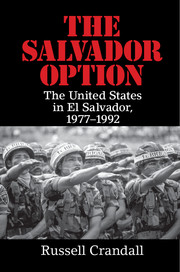Book contents
- Frontmatter
- Dedication
- Epigraph
- Contents
- List of Figures
- List of Organizations
- Acknowledgments
- 1 Introduction
- PART ONE EL SALVADOR IN THE COLD WAR
- PART TWO JIMMY CARTER
- PART THREE RONALD REAGAN
- 19 Reagan Arrives
- 20 Reagan and Salvador
- 21 El Mozote
- 22 Another Vietnam
- 23 Solidarity
- 24 Troop Cap and Certifying Human Rights
- 25 Reagan Gambles on Elections, 1982
- 26 The Shultz Doctrine
- 27 Human Rights
- 28 Henry Kissinger
- 29 Contras
- 30 “Elections Yes, Dialogue No,” 1984 Presidential Election
- 31 La Palma
- 32 Esquipulas
- 33 Counterinsurgency I
- 34 Counterinsurgency II
- 35 Zona Rosa
- 36 Air War
- 37 José Napoleón Duarte
- 38 Iran-Contra
- PART FOUR GEORGE H. W. BUSH
- PART FIVE POSTWAR
- Notes
- Bibliography
- Index
22 - Another Vietnam
from PART THREE - RONALD REAGAN
Published online by Cambridge University Press: 05 June 2016
- Frontmatter
- Dedication
- Epigraph
- Contents
- List of Figures
- List of Organizations
- Acknowledgments
- 1 Introduction
- PART ONE EL SALVADOR IN THE COLD WAR
- PART TWO JIMMY CARTER
- PART THREE RONALD REAGAN
- 19 Reagan Arrives
- 20 Reagan and Salvador
- 21 El Mozote
- 22 Another Vietnam
- 23 Solidarity
- 24 Troop Cap and Certifying Human Rights
- 25 Reagan Gambles on Elections, 1982
- 26 The Shultz Doctrine
- 27 Human Rights
- 28 Henry Kissinger
- 29 Contras
- 30 “Elections Yes, Dialogue No,” 1984 Presidential Election
- 31 La Palma
- 32 Esquipulas
- 33 Counterinsurgency I
- 34 Counterinsurgency II
- 35 Zona Rosa
- 36 Air War
- 37 José Napoleón Duarte
- 38 Iran-Contra
- PART FOUR GEORGE H. W. BUSH
- PART FIVE POSTWAR
- Notes
- Bibliography
- Index
Summary
El Salvador is Vietnam in Spanish.
– Bumper sticker from the 1980sThe Reagan administration, particularly Reagan – had two rules – one, the insurgents weren't going to win, but secondly we were not going to introduce combat troops to El Salvador or anywhere else in Central America.
– Roger Fontaine, NSC Director of Inter-American Affairs, 1981–1983It should be clear to anyone who reads newspapers that our side is not winning this war.
– Michael Barnes, Democratic Congressman of Maryland, 1983Not Anything More Than Carter Plus
As the situation in El Salvador continued to take shape under Reagan's administration, the growing chorus of skeptics remained focused on the hardline public rhetoric suggesting that the United States would stop communism at any cost, even if it violated democracy or human rights. Marked increases in military and development aid and strident rhetoric during Reagan's initial year in office in 1981 were just the first steps on a slippery slope of what would be a massive U.S. military involvement in El Salvador. Beneath the surface though, and certainly from what the U.S. Embassy was recommending, the Reagan Doctrine in El Salvador remained Carter plus. Even Reagan himself argued that his approach was a continuation of what his predecessor had started. “They [the Carter administration] were doing what we're doing [in El Salvador]: sending aid…of the same kind we're sending.” In a separate speech to the Organization of American States (OAS), Reagan forcefully defended America's right to stop the communist threat in El Salvador, but added, “We will not walk away from human rights problems.”
At the same time, a mounting chorus of critics interpreted Reagan's initial responses to El Salvador, and more broadly Central America, as inherently radical. One critic wrote in 1981:
A nation of virtually no inherent strategic or economic interest to the United States, El Salvador, has suddenly become a symbol – a vehicle through which the Reagan Administration hopes to set the tone, by dint of example, for its whole foreign policy. Because the war in El Salvador looks like an easy victory, it provides a perfect opportunity for the new administration to demonstrate its willingness to use force in foreign affairs, its intent to de-emphasize human rights, and its resolve to contain the Soviet Union.
- Type
- Chapter
- Information
- The Salvador OptionThe United States in El Salvador, 1977–1992, pp. 232 - 238Publisher: Cambridge University PressPrint publication year: 2016

